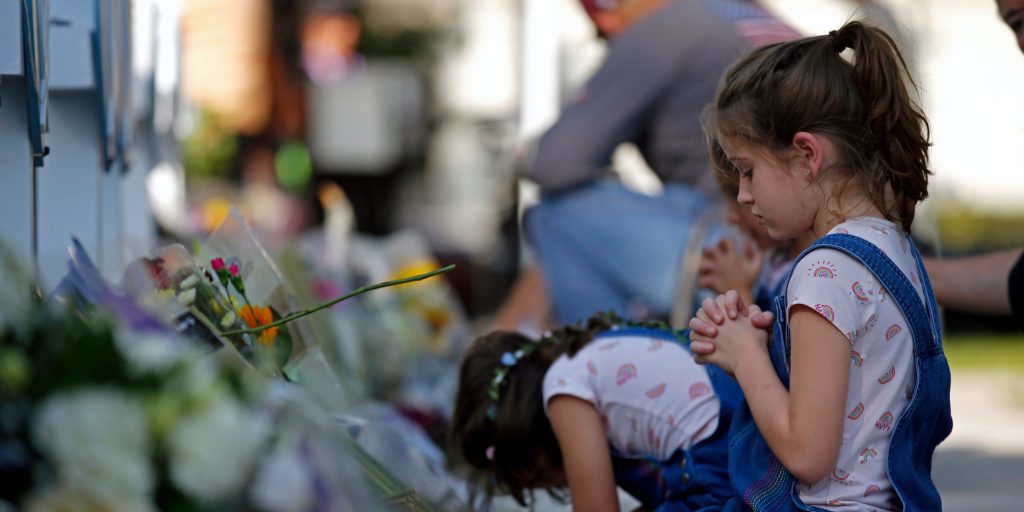- Child survivors of Tuesday's mass shooting had their sense of safety "rattled," a psychologist said.
- Horrifying first-hand accounts from kids in the besieged classroom have begun to emerge.
- One child said he hid with his friends under a table, while another girl played dead.
Young children who survive school shootings experience a "fundamental rattling" of their sense of safety, and often have long, non-linear healing journeys ahead of them, a child trauma psychologist told Insider.
On Tuesday, an 18-year-old gunman opened fire at Robb Elementary School in Uvalde, Texas, killing 21 people, including 19 children and two teachers, all of whom were in the same fourth-grade classroom.
First-hand accounts from the tragedy and its aftermath have begun to emerge, including stories of terrified parents who urged police to storm the building during the shooting, and agonizing descriptions of families' mournful sobs upon learning their children did not survive.
But it's details from the survivors themselves — the 10- and 11-year-old students who witnessed the gunman's massacre — that underline the vivid horrors of Tuesday's tragedy.
"It's time to die"
A fourth-grade boy who survived the shooting told KENS 5 about the harrowing moments he and his classmates first realized they were under attack. After firing a shot at an adjoining door, the shooter walked into the young boy's classroom, he said.
"He came in and he crouched a little bit and he said, he said 'It's time to die,'" the fourth-grader told the outlet.
Upon hearing gunshots, the boy said he immediately went to hide and told his friend to do the same. He and four other students concealed themselves under a table with a tablecloth, out of sight of the shooter.
"I was hiding hard," the boy said. "And I was telling my friend to not talk because he is going to hear us."
In one of the most chilling accounts from inside the classroom, the boy said the shooting continued even after law enforcement arrived to help.
"When the cops came, the cop said: 'Yell if you need help!' And one of the persons in my class said 'Help.' The guy overheard and he came in and shot her," the boy said. "The cop barged into that classroom. The guy shot at the cop. And the cops started shooting."
When the shooting finally stopped, "I just put my hand out," he said. "I got out with my friend. I knew it was police. I saw the armor and the shield."
The fourth-grader told the outlet that hugs from his family and talking about his experiences with a counselor have helped in the aftermath. Seeing his friend who survived also provided a moment of reprieve.
Erum Nadeem, a psychology professor at Rutgers University and clinical psychologist by training, told Insider that maintaining a sense of community support and allowing children to discuss and digest the incident in developmentally appropriate ways is a key component to healing.
"Think about that fundamental rattling of your sense of safety," she said. "It's so rattling for everyone."
"He's going to come get us"
Miguel Cerrillo told The Washington Post that he spotted his 11-year-old daughter Miah being loaded onto a school bus shortly after the shooting. The young girl was covered in blood.
Through the window of the bus, she began to describe what she had just experienced in the besieged classroom: Miah said she laid on the body of one of her bloody classmates so the gunman would believe they were both dead. Her classmate was initially breathing, but by the time the shooting had subsided, the girl had stopped breathing.
"Miah got some blood and put it on herself so she could pretend she was dead," her aunt told NBCDFW.
The children who were able to take proactive steps to protect themselves — hiding under a table or pretending to be dead — were essentially acting in "fight or flight" mode, Nadeem said.
"Basically, they perceived the threat, assessed the situation, then our brains go into the fight or flight or freeze response," she told Insider. While previous school shooting drills or preparation may have played a role in their quick thinking, Nadeem said she's unsure how much of that past training was really present in their minds in the moment.
Miah's father told the outlet that his daughter said she also grabbed a cell phone from the hands of her teacher, who had just been fatally shot, and attempted to call 911.
The young girl was left with bullet fragments throughout her body. On Tuesday night, she told her dad to get his gun, because "he's going to come get us," Miguel recalled his daughter saying, according to The Post.
A prolonged feeling of hyper-vigilance and "feeling like you need to be on watch, on edge" is common among trauma survivors, Nadeem said. The brain stores traumatic memories in a visceral way that can lead to responses such as ongoing fear, avoidance, and inability to concentrate.

"Like she was having a heart attack"
Erika Escamilla's niece was in the classroom one door over from the shooting, she told The Post. When the young girl was leaving the school after the shooting, she saw inside the classroom where 19 of her schoolmates were murdered.
"She's traumatized. She said she felt like she was having a heart attack," Escamilla told the outlet. "She saw blood everywhere."
Hillcrest Memorial funeral home in Uvalde transformed into a meeting place for survivors following the attack, The Post reported. Teachers and students who made it out alive could be seen rocking themselves and holding their ears while screaming, Escamilla said. Others appeared to be in shock, staring out in silence.
Marcela Cabralez, a pastor who was called to pray with survivors, told the newspaper that her 9-year-old granddaughter was eating lunch when the shooting began and is now fearful of sudden attacks; her grandson hid in a bathroom.
"They just don't feel safe anymore," Cabralez said.
